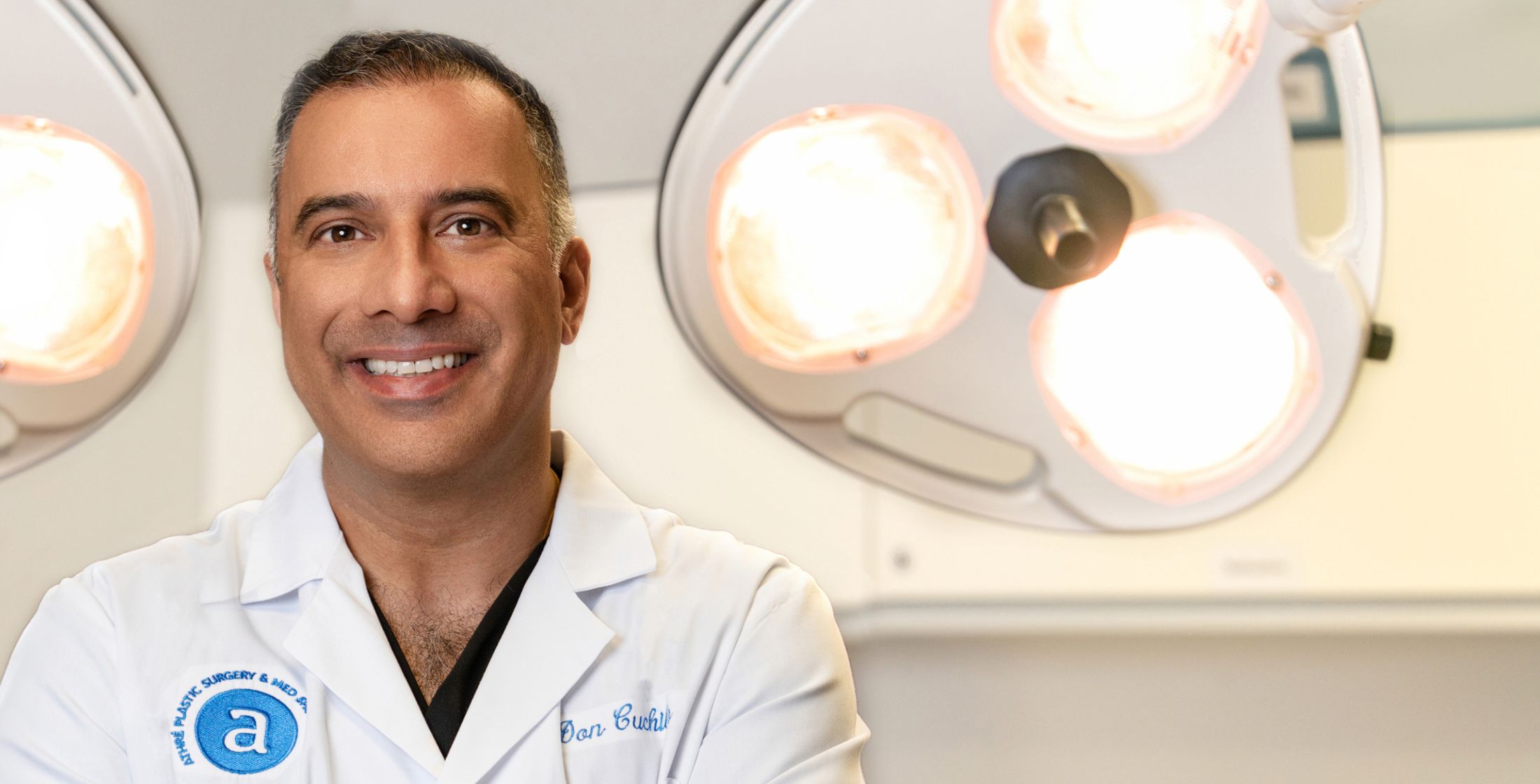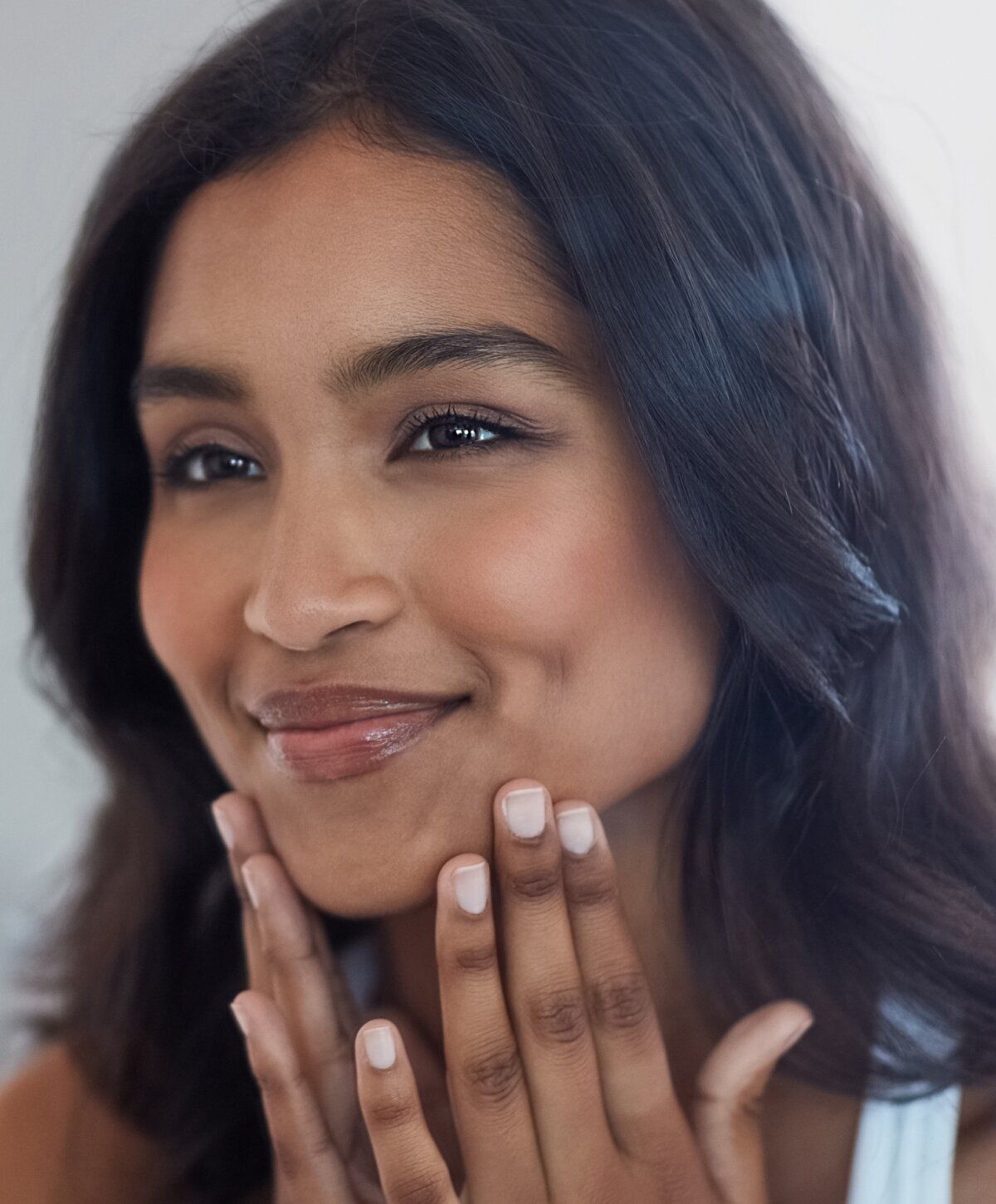



Do you have bags under your eyes or excess skin in your upper eyelids? Blepharoplasty in Houston with facial plastic surgeon Dr. Raghu Athré can improve the look of both the upper and lower lids. As a double-board-certified facial plastic surgeon, Dr. Raghu Athré utilizes his expertise and meticulous technique to achieve natural-looking enhancements that harmonize with your unique facial features. Discover the Athré Facial Plastics difference.

1 of 29

Upper blepharoplasty is one of the most common cosmetic surgical procedures. It is performed to rejuvenate and enhance the upper eyelid region. With age, the upper eyelid can become droopy, hooded, or saggy. The excess skin can be so severe that it can affect the field of vision.
From a surgical standpoint, this is due to excess skin of the upper eyelid (dermatochalasis or dermatochalasia) and herniated fat. The upper eyelid has two fat compartments: the middle fat pad and the medial fat pad. As the skin and supporting tissues weaken and thin, these fat pads can bulge out causing increased fullness. Upper blepharoplasty surgery removes excess skin and fat to return the eyelids back to a youthful and natural look. In the surgery, an incision is made in the natural crease of the upper eyelid.
Despite being a common procedure, upper blepharoplasty is complicated and does not have a one-size-fits-all approach. Dr. Athré considers numerous factors, such as the natural shape of the eye, ethnic background, and skin type, to modify the eyelid surgery to obtain the best post-operative result and minimize scarring.
Prior to the procedure, the functionality of the eye to open and close properly as well as its ability to crease properly are carefully examined. Most upper blepharoplasty procedures are done under local anesthesia and take approximately one hour. Full recovery and a return to normal activity within a week after the procedure is common.
To see an upper eyelid blepharoplasty surgery, click here. Please note, the video shows actual surgical footage of an upper blepharoplasty procedure.
The eyes are the windows to the soul, and a lot of the time they are the first thing that others notice about you. Unlike full facial rejuvenation, which often requires significant downtime, the eyes are one of the easiest and quickest areas to rejuvenate. Blepharoplasty, more commonly known as eyelid surgery, is a quick and simple procedure to rejuvenate the eye region and drastically improve the overall appearance of the face.
Other common terms for blepharoplasty include eye lift, eye lift surgery, or an eyelid lift. Dr. Athré is one of the best surgeons in the Houston area for eyelid surgery. As aging occurs, the thin skin around the eyelids begins to lose its elasticity and its ability to stretch. As a result, the excess skin of the upper eyelid can begin to overhang and cause droopy eyelids or hooded eyelids. “Crow’s feet” or deep-set wrinkles can also appear around the eyes.
Other signs of aging, such as hollowing, bulging fat due to thinning skin, or excess skin around the lower eyelids and cheeks, can typically be seen around the lower eyelid. Upper and lower blepharoplasty surgery removes excess skin and fat to create a smoother, more refreshed appearance.
Surgical procedures to rejuvenate the eyes can be broken down into:
Upper Blepharoplasty: Upper blepharoplasty is a group of surgical procedures used to rejuvenate the upper eyelid. Another name for upper blepharoplasty is an eyelid lift or upper eyelid lift.
Lower Blepharoplasty: Lower blepharoplasty deals with the rejuvenation of the lower eyelids and the interface between the lower eyelids and the cheeks. Frequently, the crow’s feet region is grouped together with the skin of the lower eyelid.
Lower eyelid surgery is also called a lower blepharoplasty. Lower eyelid surgery has two main objectives: (1) Address and fat bags or fat bulging of the lower eyelid region, (2) Address the excess skin of the lower eyelid.
There are two main techniques for performing lower blepharoplasty: the subciliary approach and the transconjunctival approach. The subciliary approach uses an incision along the lower lash line, and the transconjunctival approach makes an incision in the wet, inner surface of the lower eyelid. Dr. Athré is well-versed in both of these approaches and will customize the procedure depending on what is best for your particular case.
Most lower eyelid blepharoplasty surgeries are performed under local anesthesia with oral sedation. They can also be performed under general anesthesia based on patient preference. Most lower eyelid blepharoplasty patients can return to daily life activities within 24 hours and are able to wear makeup and return to work within 7-8 days after surgery.
Asian eyelid surgery is a type of upper blepharoplasty that specifically addresses the concerns of Asian patients. Asian patients may have one or more of the following upper eyelid characteristics that separate them from patients with other ethnic backgrounds:
These characteristics can add complexity to eyelid surgery in Asian patients. These patients need more detailed analysis to prevent over-Westernizing their eyelids, which can cause excessive and possible irreversible scarring. Asian eyelid surgery can be done to achieve a natural crease of the upper eyelid and remove multiple creases to create one, singular dominant crease.


Not smoking and not rubbing the area around your eyes can significantly help prevent the early onset or wrinkles and under eye sagging. Also, sunglasses while outside will prevent photodamage to the thin skin around the eyes and prevent squinting. Chronic squinting in bright sun will increase the prevalence and formation of fine lines in the crow's feet area and in the lower eyelid skin. A medical-grade sunscreen will also prevent sun damage to the thin eyelid skin. The next level of rejuvenation is to use medical-grade skin care products. The Athré Skin Rx Eye Cream is formulated with retinol and hyaluronic acid to reduce fine lines and plump tissues. For patients who wish to drastically reduce the appearance of wrinkles around the eye area, Botox may be appropriate. Botox, Dysport, and other neuromodulators are excellent for softening the fine lines in the crow's feet region. Botox may also provide a slight lift of the eyebrows, causing the amount of excess skin on the upper eyelid to appear less significant. Fillers can help plump up the lower eyelid and cheek area to reduce the appearance of lower eyelid bags. Dr. Athré has a specific filler procedure just for this area called Ocu Rx™.Finally, chemical peels and laser resurfacing can thicken thinned tissues and remove much of the lines and wrinkles in the area around the eye.

Eyelid surgery, encompassing both upper and lower blepharoplasty, addresses a range of age-related concerns in the delicate eye area:
With blepharoplasty Houston patients are offered a range of benefits that extend far beyond aesthetics. Here's a closer look at how eyelid surgery can enhance your appearance, well-being, and even your vision:
Restore a youthful and refreshed look: The eyes are a central feature of the face, and their appearance can significantly impact how we perceive age and energy. Drooping eyelids, under-eye puffiness, and wrinkles can create a tired or aged look. Eyelid surgery addresses these concerns by strategically addressing upper eyelid drooping, under-eye puffiness, and wrinkles and fine lines.
Improved field of vision (in some cases): In some cases, drooping upper eyelids can obstruct your peripheral vision. Eyelid surgery, particularly upper blepharoplasty, can address this issue by lifting the eyelid and improving your field of view.
Enhanced confidence and self-esteem: By restoring a more youthful and refreshed eye area, eyelid surgery can boost your confidence and help you feel empowered in your everyday life.
Long-lasting results: Modern eyelid surgery techniques offer long-lasting results. While individual results may vary, the effects of a successful eyelid surgery can be enjoyed for several years.
Minimally invasive options for faster recovery: Eyelid surgery is a minimally invasive procedure with a relatively quick recovery. Dr. Athré utilizes advanced techniques to minimize downtime and discomfort.
Natural-looking results: At Athré Facial Plastics, achieving natural-looking results is paramount. Dr. Athré prioritizes techniques that subtly address concerns in the upper and lower eyelid areas. The final outcome complements your facial features, maintaining a balanced and harmonious appearance.
A consultation with Dr. Athré is the best way to determine whether you’re a good candidate for eyelid surgery. Our Houston Blepharoplasty procedure offers long-lasting rejuvenation for individuals concerned about sagging upper eyelids, under-eye puffiness, fine lines, or drooping upper eyelids that impact vision.
During your consultation, Dr. Athré will ask you about your medical history to ensure that cosmetic surgery can be performed safely. He will also learn about your goals and provide you with a clear idea of the results you can expect to achieve.
After eyelid surgery, you will have some bruising and swelling around the eyelids. Dr. Athré will provide you with detailed aftercare instructions and check your healing at post-operative appointments. Blepharoplasty patients can usually return to work after 7-8 days. The appearance of the eye area will continue to improve over several months as residual swelling diminishes and the tissues settle into their optimal position.

Blepharoplasty offers long-lasting improvements. While individual results may vary, the effects of a successful surgery can be enjoyed for 10-15 years or even longer. This longevity depends on factors like your anatomy, lifestyle choices, and sun exposure. Dr. Athré prioritizes techniques that achieve subtle and natural-looking improvements.
While blepharoplasty offers long-lasting improvements, certain lifestyle factors can influence the longevity of your results. Maintaining a stable weight, avoiding excessive sun exposure and smoking, and following a good skincare routine can all contribute to preserving your refreshed eye area.
Upper eyelid surgery usually takes 1 hour, and lower eyelid surgery usually takes 1 hour 30 minutes. Most upper and lower eyelid surgeries take approximately 2 hours for the surgical procedure.
Within 7 days after surgery, most patients are able to wear cover-up makeup and return to normal activities.
Most patients will only undergo one lower blepharoplasty procedure in their lifetime. The duration of upper blepharoplasty is variable. If a patient has their first upper blepharoplasty around age 40, they may need a revision procedure in their late 50s.
Blepharoplasty is minimally painful, and cold compresses and pain medication can help ease the discomfort during recovery. Most of Dr. Athré’s patients take no pain medications other than Tylenol for pain management.
There is no perfect age for blepharoplasty surgery. Patients who get the best results are normally above the age of 35. However, younger patients may opt for blepharoplasty surgery based on their individual facial anatomy and skin condition. The most important variables are health history, realistic expectations, and anatomy.
Blepharoplasty may leave a small, temporary scar that will heal over time until it is virtually nonexistent.
Eyelid procedures are done under local anesthesia, which will numb the area of the incision. This type of anesthesia is usually enough for upper eyelid procedures. Lower eyelid procedures are usually done with sedation as well to keep you awake but comfortable. Patients can elect to have their procedure under general anesthesia.